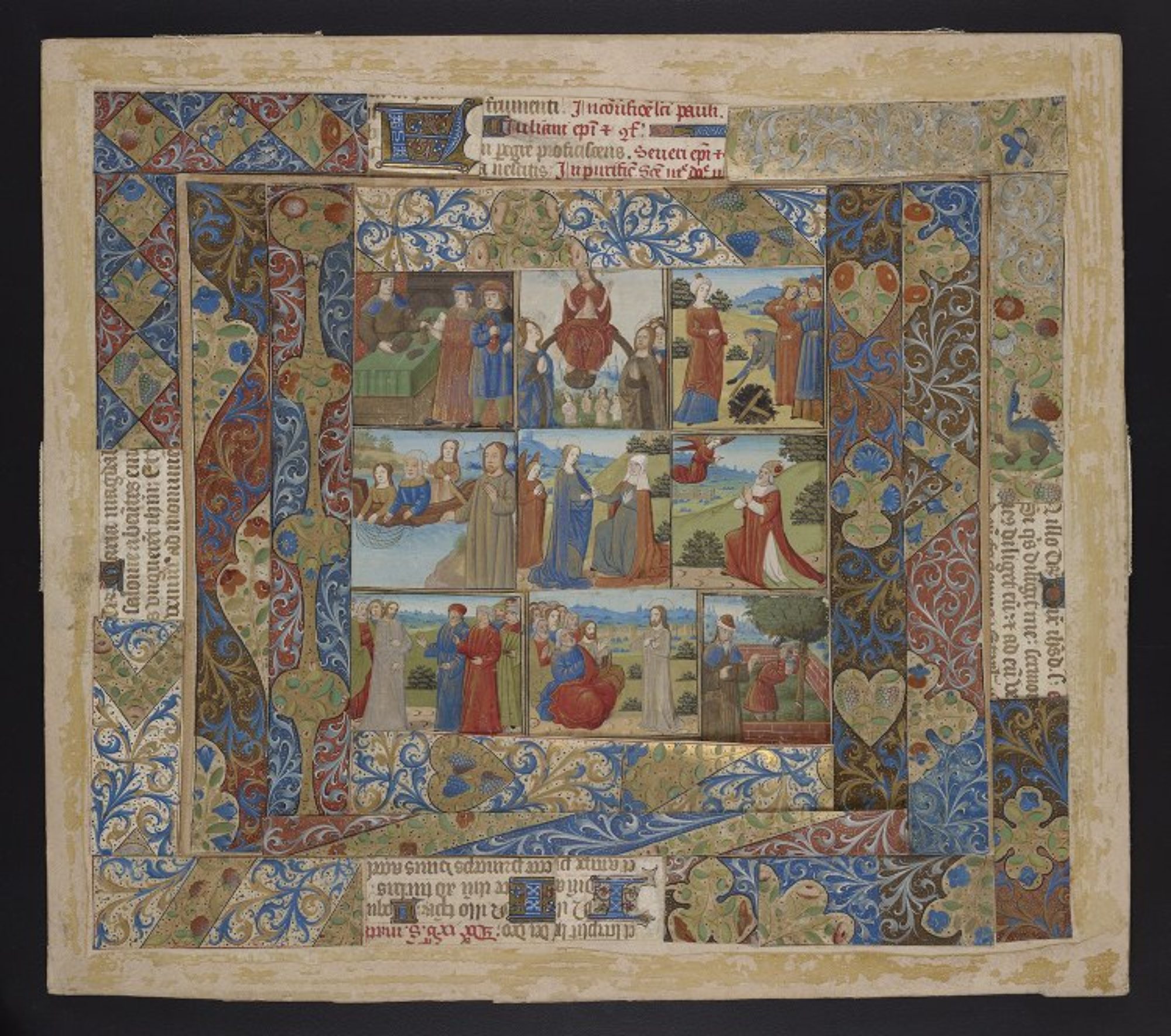This week I presented this talk as the opening keynote for the Digital Scholarly Editions as Interfaces conference at the University of Graz. The conference is hosted by the Centre for Information Modelling, Graz University, the programme chair is Georg Vogeler, Professor of Digital Humanities and the program is endorsed by Dixit – Scholarly Editions Initial Training Network. Thanks so much to Georg for inviting me! And thanks to the audience for the discussion after. I can’t wait for the rest of the conference.
What is an edition anyway?
Thank you to Georg Voegler for inviting me to present the keynote at the symposium, thank you Dixit for making this conference possible, and danke to welcoming speakers for welcoming us so warmly. I’m excited to be here and looking forward to hear what the speakers have to say about digital scholarly editions as interfaces. Georg invited me here to talk about my work on medievalists use of digital editions. But first, I have a question.
What is an edition? I think we all know what an edition is, but it’s still fun, I find, to investigate the different ways that people define edition, or think about editions, so despite the title of this talk, most of what I’m going to be talking about is various ways that people think about editions and why that matters to those of us in the room who spend our time building editions, and at the end I’m going to share my thoughts on directions I’d like to see medieval editions in particular take in the future.
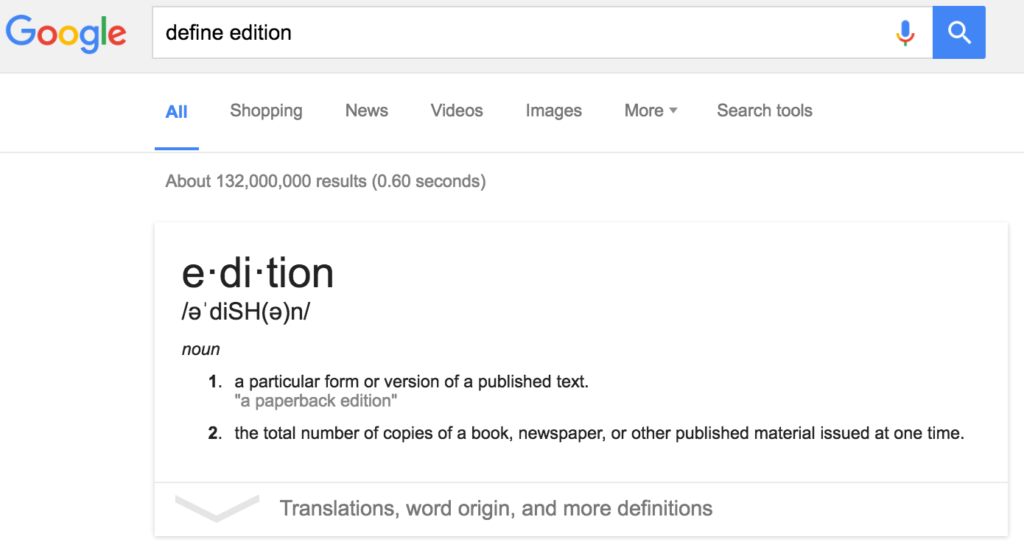
I’ll admit that when I need a quick answer to a question, often the first place I turn to is Google. Preparing for this talk was no different. So, I asked Google to define edition for me, and this is what I got. No big surprise. Two definitions, the first “a particular form or version of a published text,” and the second “the total number of copies of a book, newspaper, or other published material issued at one time.” The first definition here is one that’s close to the way I would answer this question myself. I think I’d generally say that an edition is a particular version of a text. It might be a version compiled together from other versions, like in a scholarly critical edition, but need not be. I’m a medievalist, so this got me thinking about texts written over time, and what might make a text rise to the level of being an “edition”, or not.
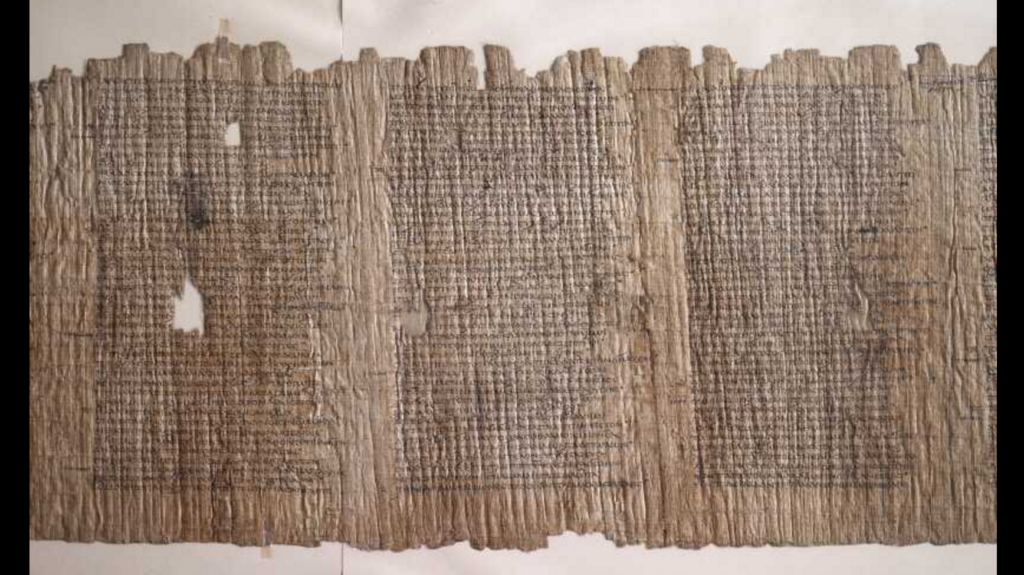
So here is some text from the Illiad, written on a papyrus scroll I the 2nd century BC. The scroll is owned by the British Museum, Papyrus 114 also known as the Bankes Papyrus. The Illiad, you probably know, is an ancient Greek epic poem set during the Trojan war, which focuses on a series of battles between King Agamemnon and the warrior Achilles. If you are a Classicist, I apologize in advance for simplifying a complex textual situation. If you aren’t a Classicist, if you’ve read the Illiad you probably read it in a translation from Greek into your native language, and this text most likely would have been presented to you as “The Text of The Illiad” – that is, a single text. That text, however, is built from many small material fragments that were written over a thousand years, and which represent written form of text that was composed through oral performance. The Bankes Papyrus is actually one of the most complete examples of the Illiad in papyrus form – most surviving examples are much more fragmentary than this.
![Venetus A, aka Marcianus Graecus Z. 454 [=822] (ca. 950), fol. 12r](http://www.dotporterdigital.org/wp-content/uploads/2016/09/venetus_a_folio_12r.jpg)
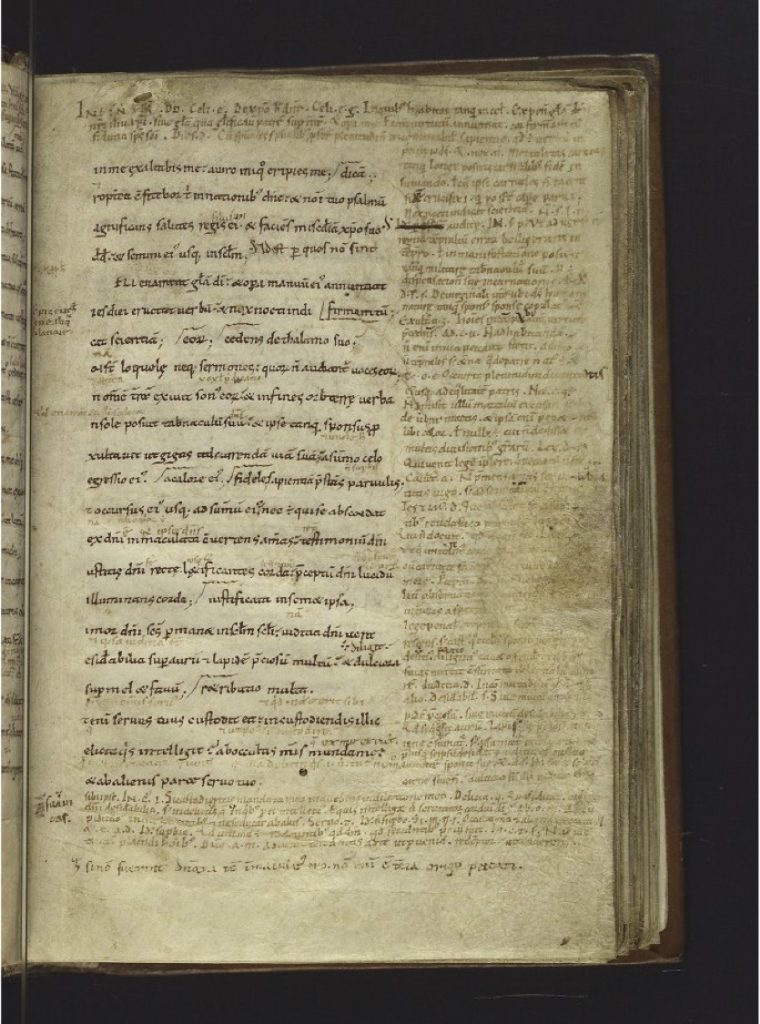
The Venetus A is just one example of a medieval glossed manuscript. Another more common genre of glossed manuscripts are Glossed Psalters, that is, texts of the Psalter written with glosses, quotes from the Church Fathers, included to comment on specific lines. Here is an example of a Glossed Psalter from the University of Pennsylvania’s collection. This is a somewhat early example, dated to around 1100, which is before the Glossa Ordinara was compiled (the Glossa Ordinaria was the standard commentary on the scriptures into the 14th century). Although this isn’t as complex as the Venetus A, you can still see at least two levels of glossing, both in the text and around the margins.
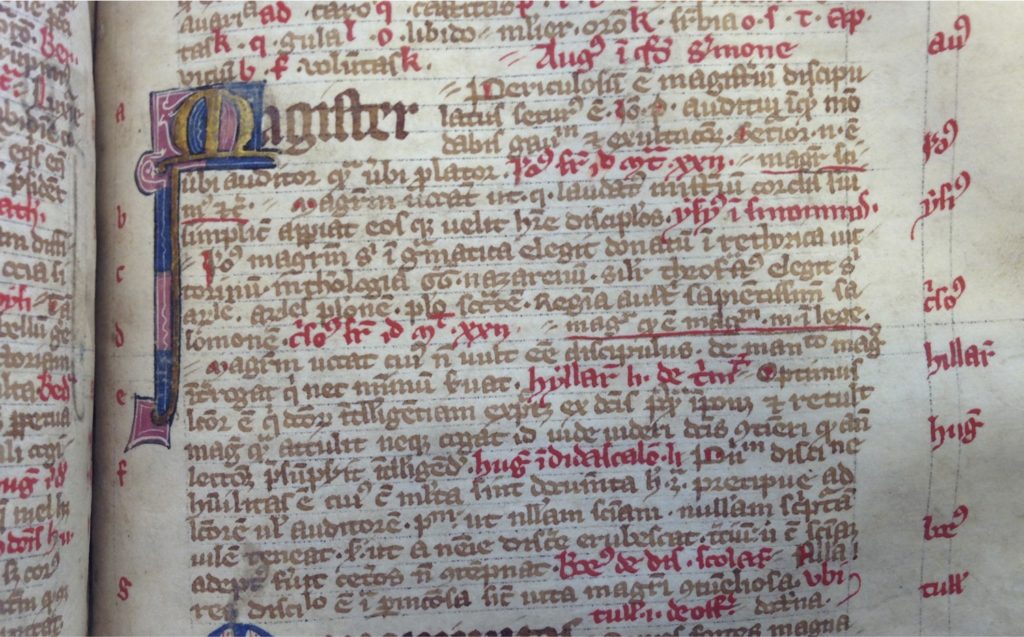
One more example, a manipulus florum text from another University of Pennsylvania manuscript. Thomas of Ireland’s Manipulus florum (“Handful of flowers”), compiled in the early 14th century, belongs to the genre of medieval texts known as florilegia, collections of authoritative quotations that are the forerunners of modern reference works such as Bartlett’s Familiar Quotations and The Oxford Dictionary of Quotations. This particular florilegium contains approximately 6000 Latin proverbs and textual excerpts attributed to a variety of classical, patristic and medieval authors. The flora are organized under alphabetically-ordered topics; here we see magister, or teacher. The red text is citation information, and the brown text is the quotes.
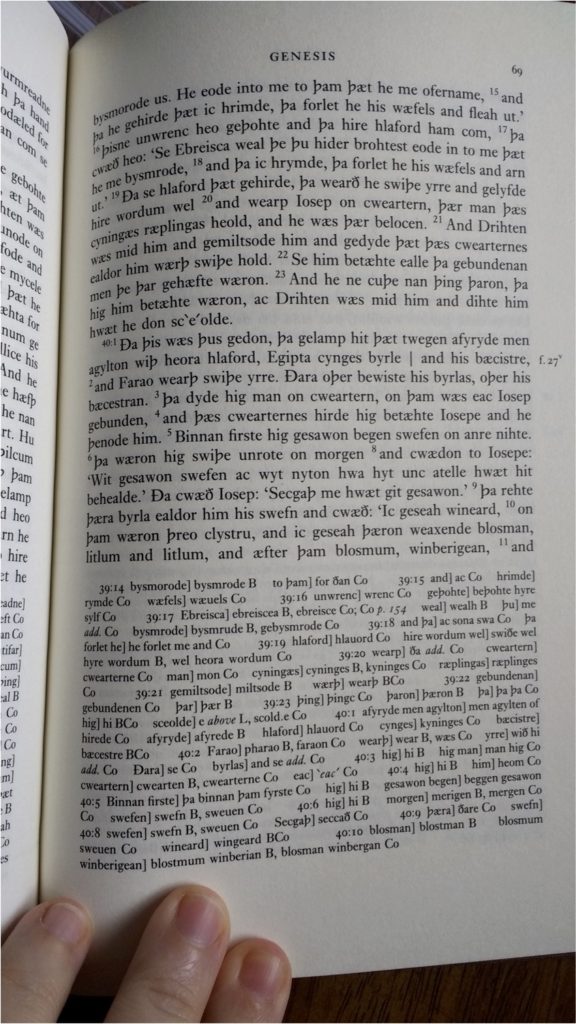
Now let’s take a look at a modern edition, Richard Marsden’s 2008 edition of The Old English Heptateuch published with the Early English Text Society. A glance at the table of contents reveals an introduction with various sections describing the history of editions of the text, the methodology behind this edition, and a description of the manuscripts and the relationships among them. This is followed by the edited texts themselves, which are presented in the traditional manner: with “the text” at the top of the page, and variant readings and other notes – the apparatus – at the bottom. In this way you can both read the text the editor has decided is “the text”, but also check to see how individual manuscripts differ in their readings. It is, I’ll point out, very similar to the presentation of the Illiad text in the Venetus A.
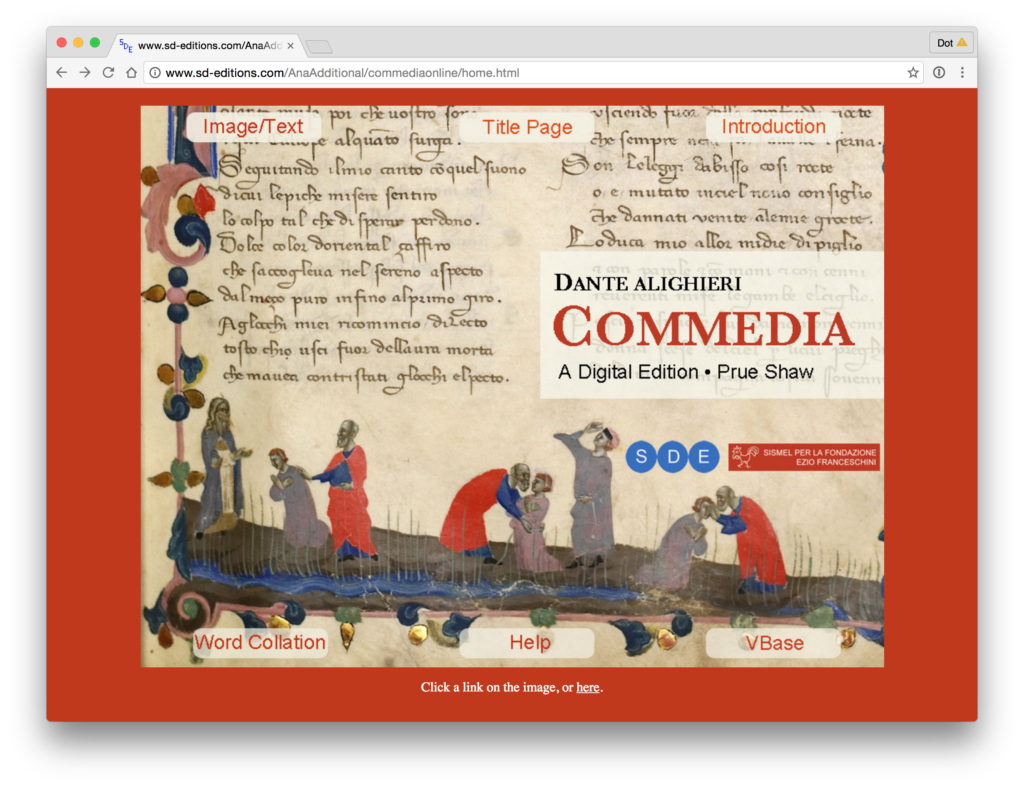
Electronic and digital editions have traditionally (as far as we can talk about there being a tradition of these types of editions) presented the same type of information as print editions, although the expansiveness of hypertext has allowed us to present this information interactively, selecting only what we want to see at any given moment and enabling us to follow trails of information via links and pop-ups. For example I have here Prue Shaw’s edition of Dante’s Commedia, published by the Scholarly Digital Editions. Here we have a basic table of contents, which informs us of the sections included in the edition.
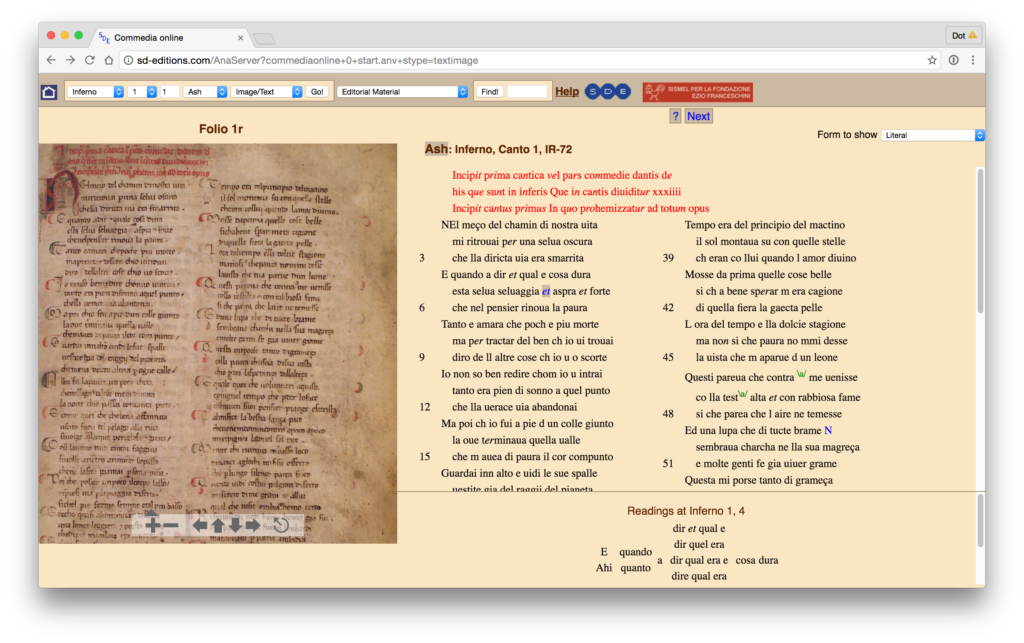
Here we have the edited text from one manuscript, with the page image displayed alongside (this of course being one of the main differences between digital and print editions), with variant readings and other notes available at the click of the mouse.
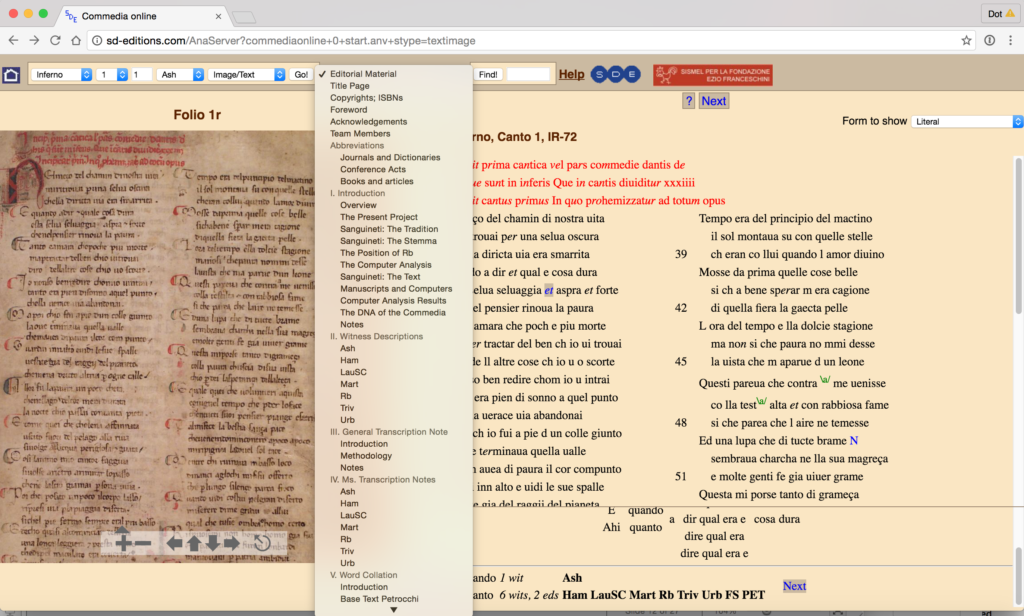
A more extensive content list is also available via dropdown, and with another click I can be anywhere in the edition I wish to be.
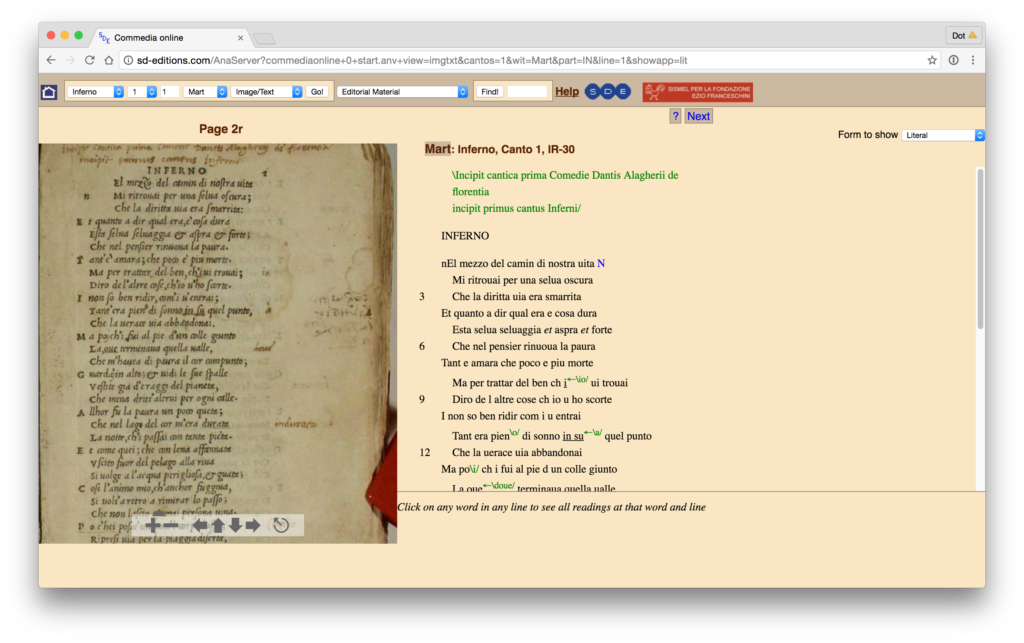
Here I am at the same point in the text, except the base text is now this early printed edition, and again the page image is here displayed so I can double-check the editor’s choices should I wish to.
With the possible exception of the Bankes Papyrus, all of these examples are editions. They reflect the purpose of the editor, someone who is not writing original text but is compiling existing text to suit some present desire or need. The only difference being the material through which the edition is presented – handwritten parchment or papyrus, usually considered “primary material”, vs. a printed book or digital media, or “secondary material”. And I could even make an argument that the papyrus is an edition as well, if I posit that the individual who wrote the text on the papyrus was compiling it from some other written source or even from the oral tradition.
I want to take a step back now from the question of what is an edition and talk a bit about why, although the answer to this may not matter to me personally, it does matter very much when you start asking people their opinions about editions. (I am not generally a fan of labels and prefer to let things be whatever they are without worrying too much about what I should call them. I’m no fun at parties.)
I’ve been studying the attitudes of medievalists towards digital resources, including editions, since I was a library science graduate student back in 2002. In May 2001 I graduated with an MA from the Medieval Institute at Western Michigan University, with a focus on Anglo-Saxon language, literature, and religious culture. I had taken a traditional course of work, including courses in paleography and codicology, Old English, Middle English, and Latin language and literature, and several courses on the reading of religious texts, primarily hagiographical texts. I was keenly aware of the importance of primary source materials to the study of the middle ages, and I was also aware that there were CD-ROMs available that made primary materials, and scholarly editions of them, available at the fingertips. There were even at this time the first online collections of medieval manuscripts (notably the Early Medieval Manuscript Collection at the Bodleian Library at Oxford). But I was curious about how much these new electronic editions (and electronic journals and databases, too) were actually being used by scholars. I conducted a survey of medievalists, asking them about their attitudes toward, and use of, electronic resources. I wrote my findings in a research paper, “Medievalists’ Use of Electronic Resources: The Results of a National Survey of Faculty Members in Medieval Studies,” which is still available if you want to read it, in the IU Bloomington institutional repository.
I conducted a second survey in 2011, and compared findings from the two surveys in an article published in 2013 in Scholarly Editing, “Medievalists and the Scholarly Digital Edition.” The methodologies for these surveys were quite different (the first was mailed to a preselected group of respondents, while the second was sent to a group but also advertised on listservs and social media), and I’m hesitant to call either of them scientific, but with these caveats they do show a general trend of usage in the 9 years between, and this trend reflects what I have seen anecdotally.
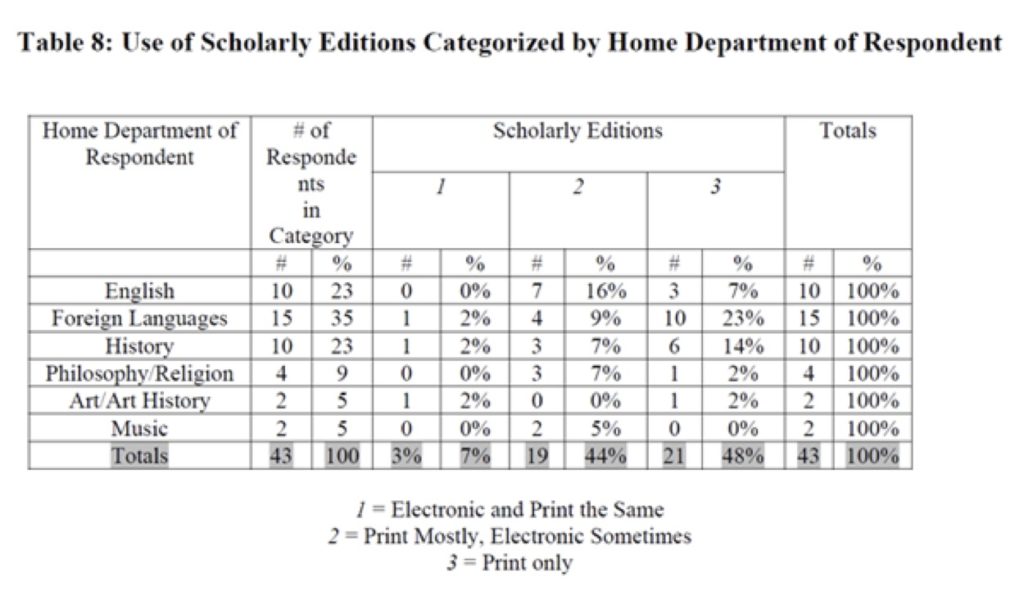
In this chart from 2002, we see that 7% of respondents reported using electronic and print editions the same, 44% print mostly, and 48% print only.
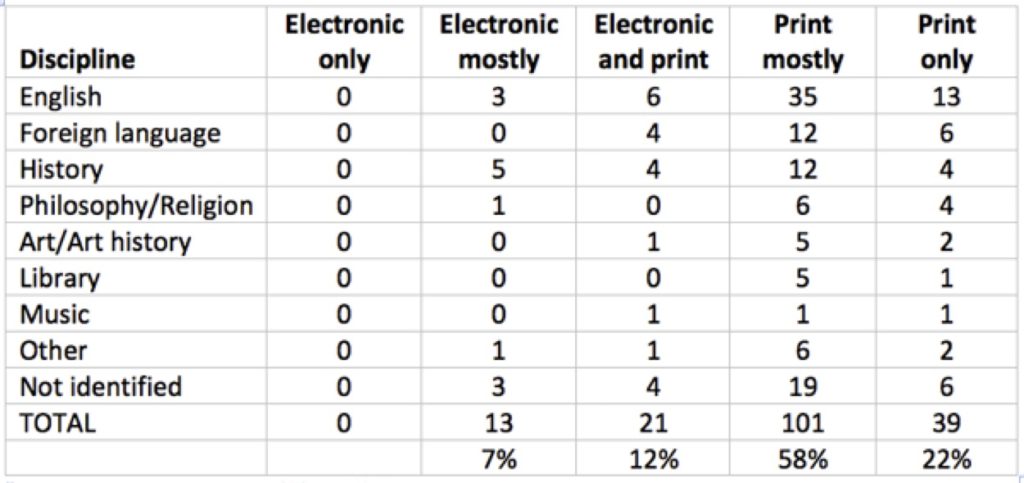
Nine years later, while still no-one reports using only electronic editions, 7% report using electronic mostly, 12% electronic and print the same, 58% print mostly, and 22% print only. The largest shift is from “print only” to “print mostly”, and it’s most clearly seen on this chart.
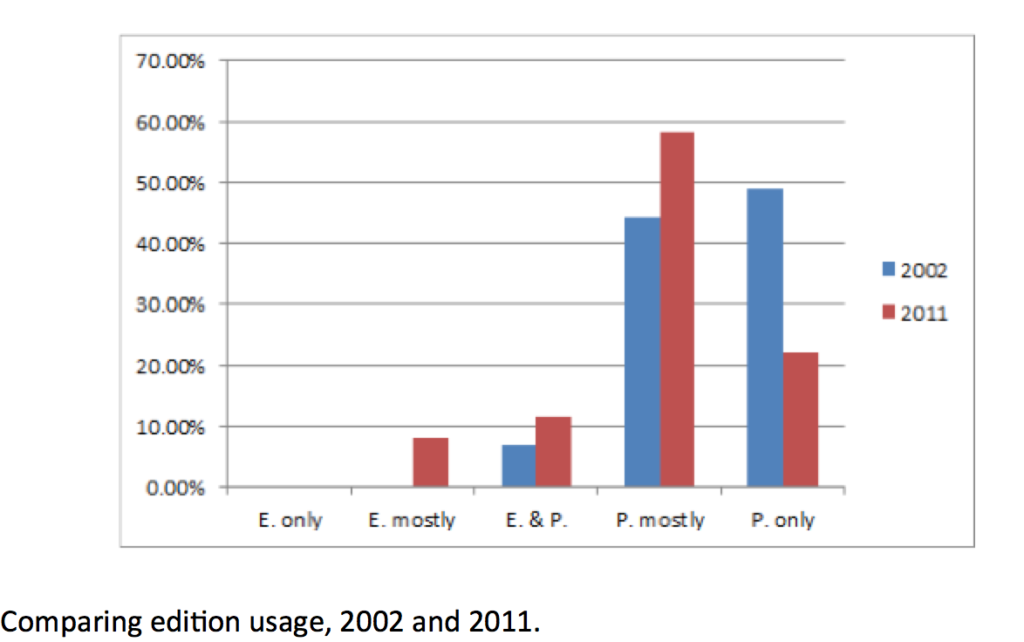
Now this is all well and good, and you’d be forgiven for looking at this chart and coming to the conclusion that all these folks had finally “seen the light” and were hopping online and on CD Rom to check out the latest high-tech digital editions in their field. But the written comments show that this is clearly not the case, at least not for all respondents, and that any issues with the survey data come from a disconnect between how I conceive of a “digital edition” and how the respondents conceive of the same.
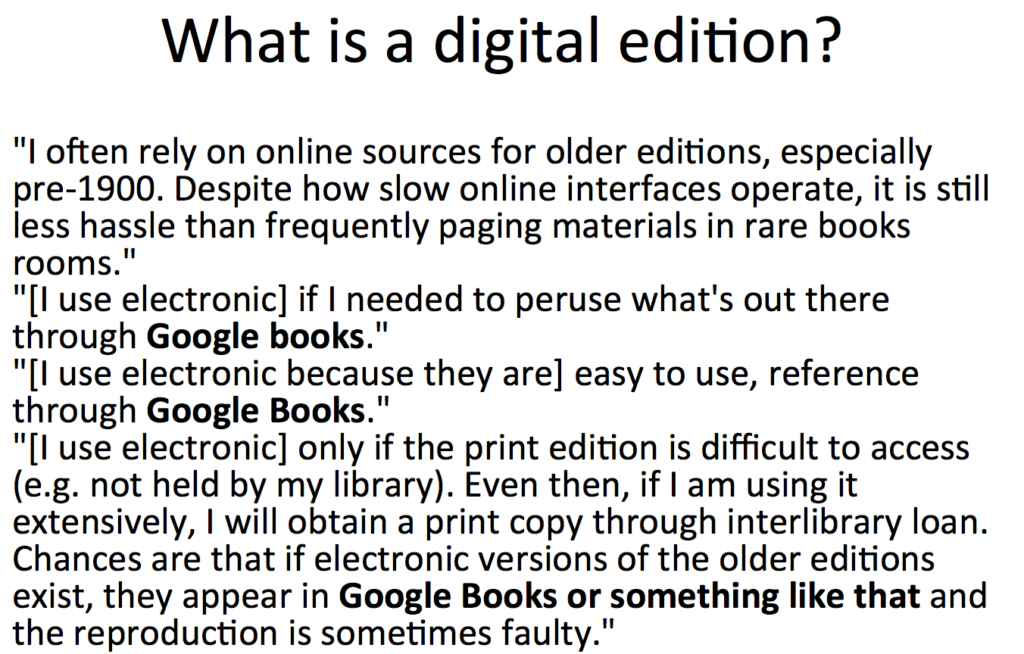
Exhibit A: Comments from four different respondents explaining when they use digital editions and how they find them useful. I won’t read these to you, but I will point out that the phrase Google Books has been bolded in three of them, and while the other one doesn’t mention Google Books by name, the description strongly implies it.
I have thought about this specific disconnect a lot in the past five years, because I think that it does reflect a general disconnect between how we who create digital editions think about editing and editions, and how more traditional scholars and those who consume editions think about them. Out of curiosity, as I was working on this lecture I asked on Facebook for my “friends” to give me their own favorite definition of edition (not digital edition, just edition), and here are two that reflected the general consensus. The first is very material, a bibliographic description that would be favored by early modernists (as a medievalist I was actually a bit shocked by this definition, although I know what an edition is, bibliographically speaking, I wasn’t thinking in that direction at that point, I was really thinking of a “textual edition”), while the second focuses not so much on how the text was edited but on the apparatus that comes along with it. Thus, an edited text by itself isn’t properly an edition, it requires material explaining the text to be a “real” edition. Interestingly, this second definition arguably includes the Venetus A manuscript we looked at earlier.
This spring, in preparation for this lecture, I created a new survey, based on the earlier surveys (which were more or less identical) but taking as a starting place Patrick Sahle’s definition of a Digital Scholarly Edition:
Digital scholarly editions are not just scholarly editions in digital media. I distinguish between digital and digitized. A digitized print edition is not a “digital edition” in the strict sense used here. A digital edition can not be printed without a loss of information and/or functionality. The digital edition is guided by a different paradigm. If the paradigm of an edition is limited to the two-dimensional space of the “page” and to typographic means of information representation, than it’s not a digital edition.
In this definition Sahle differentiates between a digital edition, which essentially isn’t limited by typography and thus can’t be printed, and a digitized edition, which is and which can. In practice most digitized editions will be photographic copies of print editions, although of course they could just be very simple text rendered fully in HTML pages with no links or pop-ups. While the results of these lines of questioning aren’t directly comparable with the 2002 and 2011 results, I think it’s possible to see a general continuing trend towards a use of digitized editions, if not towards digital editions following Sahle’s definition.
First, a word about methodology. This year’s respondents were entirely self-selecting, and the announcement of the survey, which was online, went out through social media and listservs. I didn’t have a separate selected group. There were 337 total respondents although not every respondent answered every question.
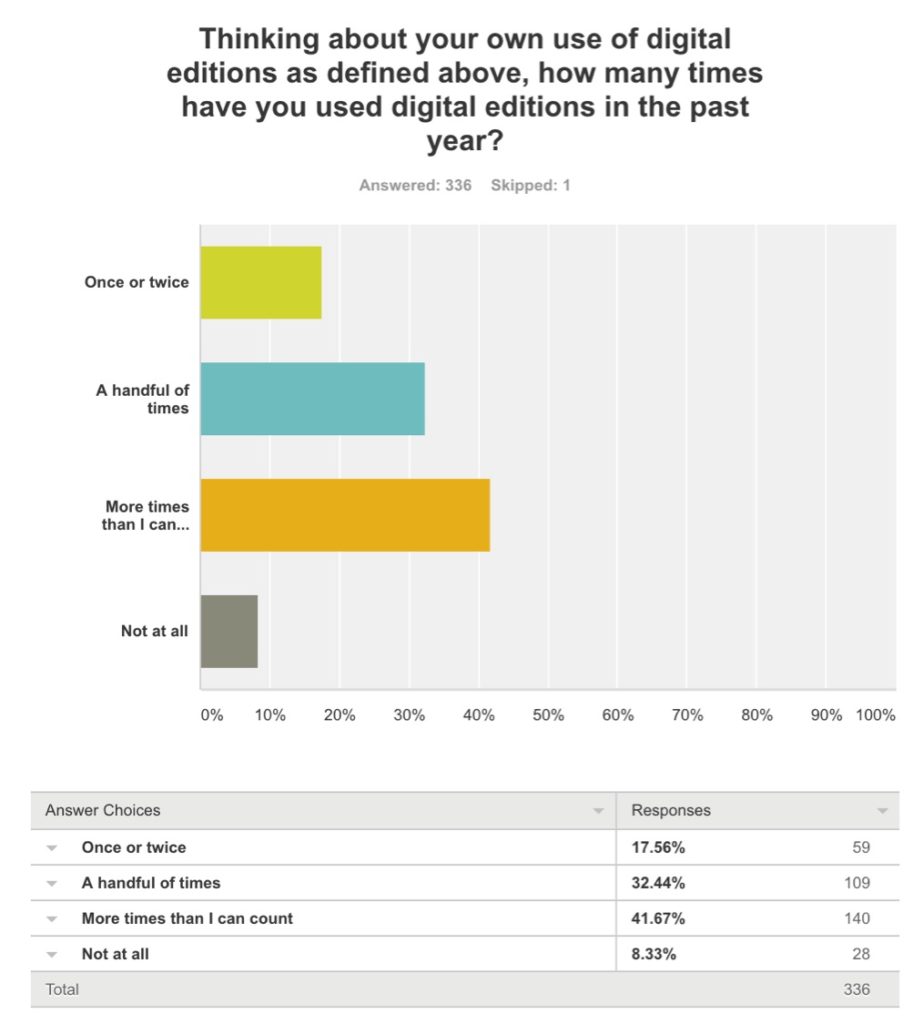
This year, I asked respondents about their use of editions – digital, digitized, and print – over the past year, focusing on the general number of times they had used the editions. Over 90% of respondents report using digital editions at all, although only just over 40% report using them “more times than I can count”.
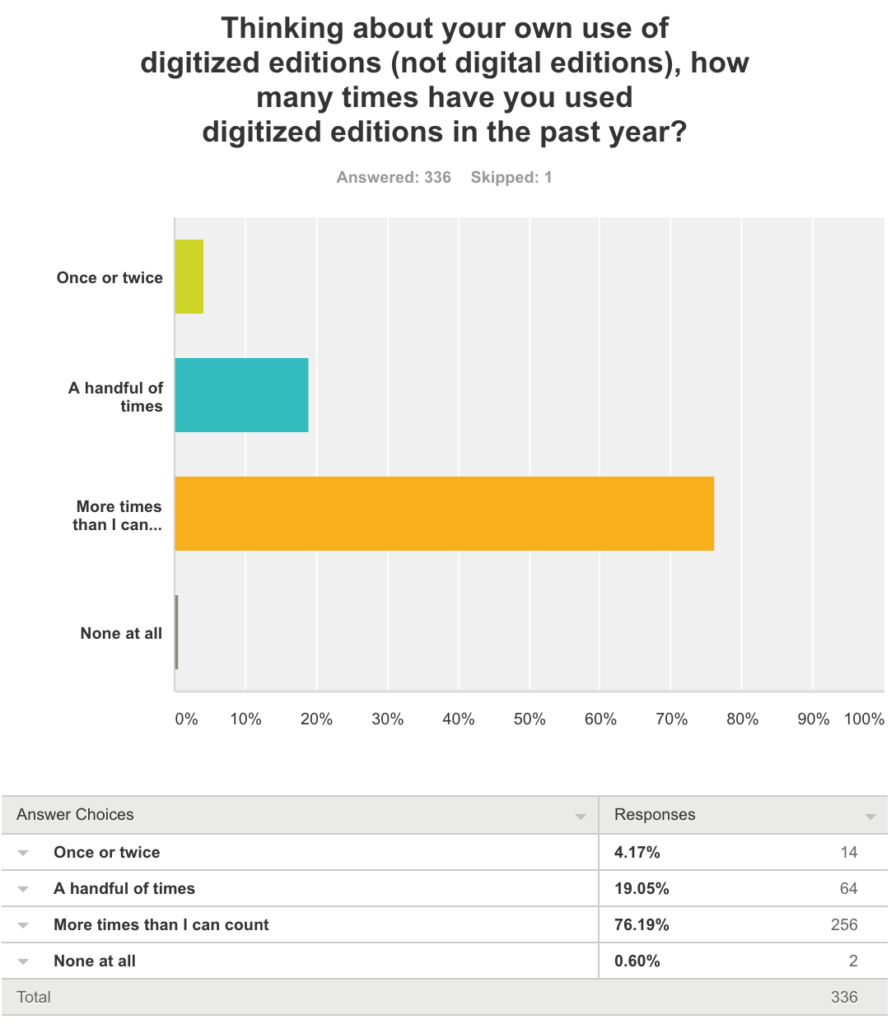
When asked about digitized editions, however, over 75% report using them “more times than I can count”, and only 2 respondents – .6% – report using them not at all.
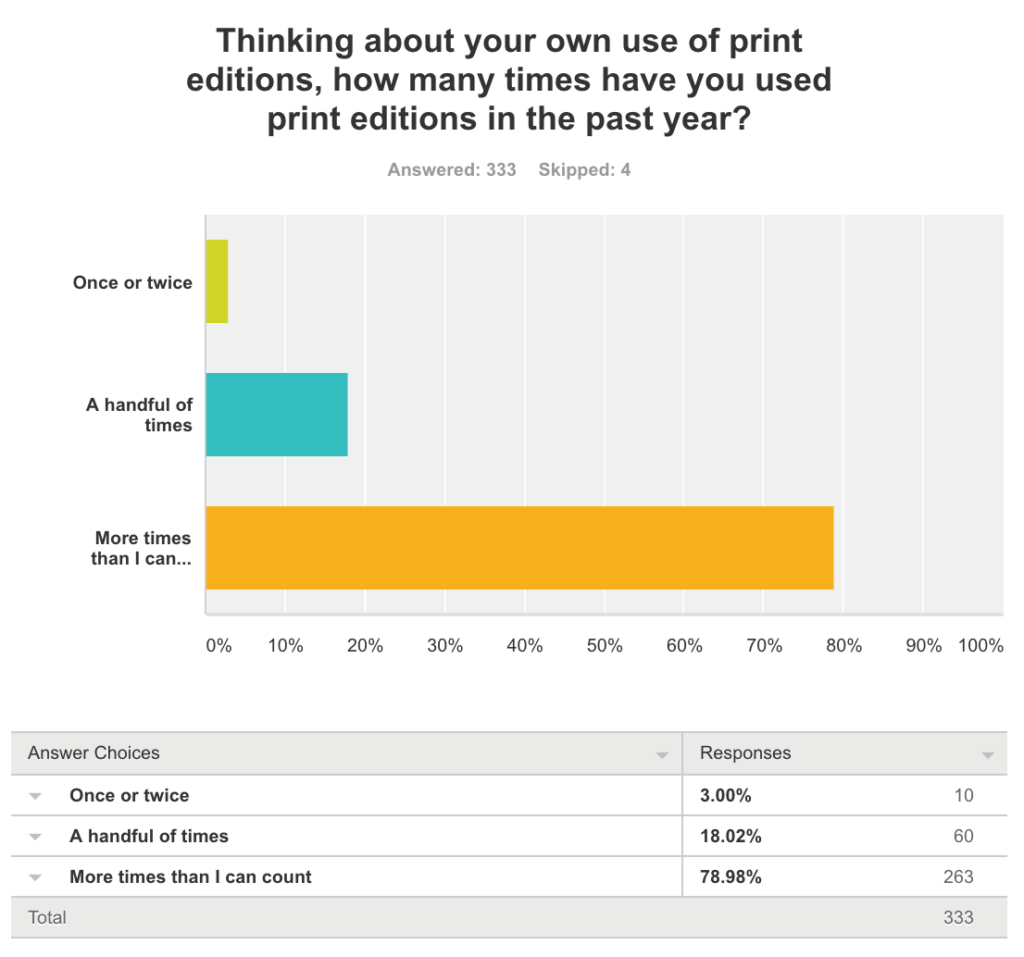
Print edition usage is similar to digitized edition usage, with about 78% reporting they use them “more times than I can count” and no respondents reporting they use them not at all. A chart comparing the three types of editions side-by-side shows clearly how similar numbers are for digitized and print editions vs. digital editions.
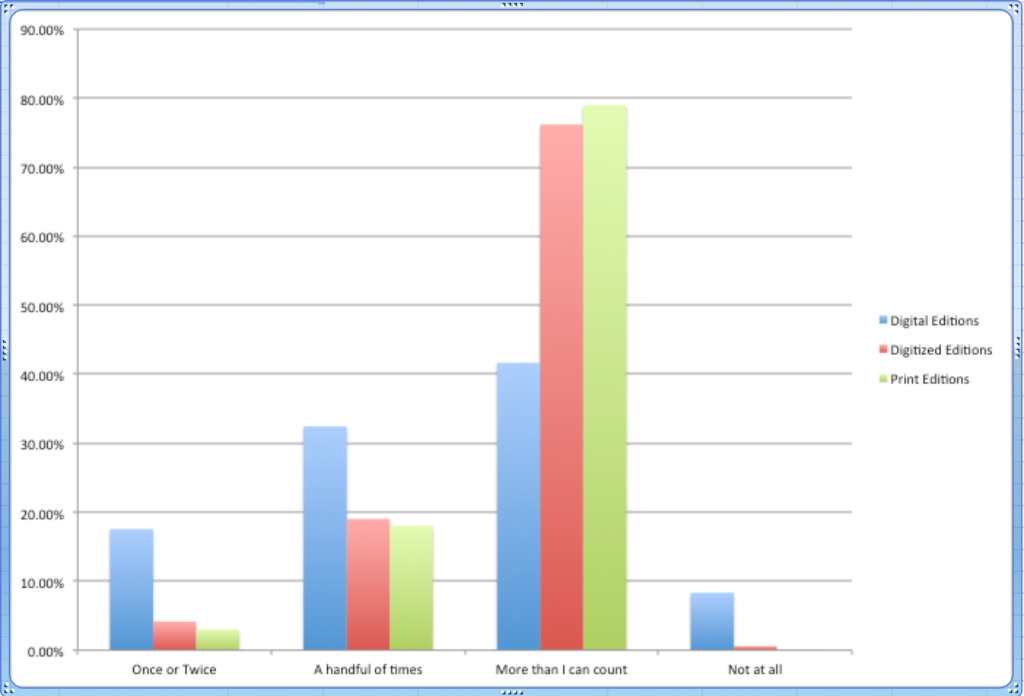
What can we make of this? Questions that come immediately to my mind include: are we building the editions that scholars need? That they will find useful? Are there editions that people want that aren’t getting made? But also: Does it matter? If we are creating our editions as a scholarly exercise, for our own purposes, does it matter if other people use them or not? It might hurt to think that someone is downloading a 19th century edition from Google Books instead of using my new one, but is it okay? And if it’s not, what can we do about that? (I’m not going to try to answer that, but maybe we can think about it this week)
I want to change gears and come back now to this question, what is an edition. I’ve talked a bit about how I conceive of editions, and how others do, and how if I’m going to have a productive conversation about editions with someone (or ask people questions on a survey) it’s important to make sure we’re on the same page – or at least in the same book – regarding what we mean when we say “edition”. But now I want to take a step back – way back – and think about what an edition is at the most basic level. On the Platonic level. If an edition is a shadow on the wall, what is casting that shadow? Some people will say “the urtext” which I think of (not unkindly, I assure you) as the floating text, the text in the sky. The text that never existed until some editor got her hands on it and brought it to life as Viktor Frankenstein brought to life that poor, wretched monster in the pages of Mary Shelley’s classic horror story. I say, we know texts because someone cared enough to write them down, and some of that survives, so what we have now is a written record that is intimately connected to material objects: text doesn’t float, text is ink on skin and ink on paper and notches in stone, paint on stone, and whatever else borne on whatever material was handy. So perhaps we can posit editions that are cast from manuscripts and the other physical objects on which text is borne, not simply being displayed alongside text, or pointed to from text, or described in a section “about the manuscript”, but flipping the model and organizing the edition according to the physical object.
I didn’t come up with this idea, I am sad to say. In 2015, Christoph Flüeler presented a talk at the International Congress on Medieval Studies titled “Digital Manuscripts as Critical Edition,” later posted to the Schoenberg Institute for Manuscript Studies blog. In this essay Flüeler asks: “… how [does] a digital manuscript [stand] in relation to a critical edition of a text. Can the publication of a digital manuscript on the internet be understood as an edition? Further: could such an edition even be regarded as a critical edition?” – His answer being, of course, yes. I won’t go into his arguments, instead I’m going to use them as a jumping-off point, but I encourage you to read his essay.
This concept is very appealing to me. I suppose I should admit now, almost at the end of my keynote, that I am not presently doing any textual editing, and I haven’t in a few years. My current position is “Curator, Digital Research Services” in the Schoenberg Institute for Manuscript Studies at the University of Pennsylvania Libraries in Philadelphia. This position is a great deal of fun and encompasses many different responsibilities. I am involved in the digitization efforts of the unit and I’m currently co-PI of Bibliotheca Philadelphiensis, a grant funded project that will digitize all the medieval manuscripts in Philadelphia, which I can only mention now but I’ll be glad to talk about more later to anyone interested in hearing about it. All our digital images are released in the public domain, and published openly on our website, OPenn, along with human readable HTML descriptions, links to download the images, and robust TEI manuscript descriptions available for download and reuse.
I also do a fair amount of what I think of as experimental work, including new ways to make manuscripts available to scholars and the public. I’ve created electronic facsimiles in the epub format, a project currently being expanded by the Penn Libraries metadata group, which are published in our institutional repository, and I also make short video orientations to our manuscripts which are posted on YouTube and also made available through the repository. In the spring I presented on OPenn for a mixed group of librarians and faculty at Vanderbilt University in Tennessee, after which an art historian said to me, “this open data thing is great and all, but why can’t we just have the manuscripts as PDFs?” So I held my nose and generated PDF files for all our manuscripts, then I did it for the Walters Art Museum as well for good measure. I posted them all to Google Docs, along with spreadsheets as a very basic search facility.
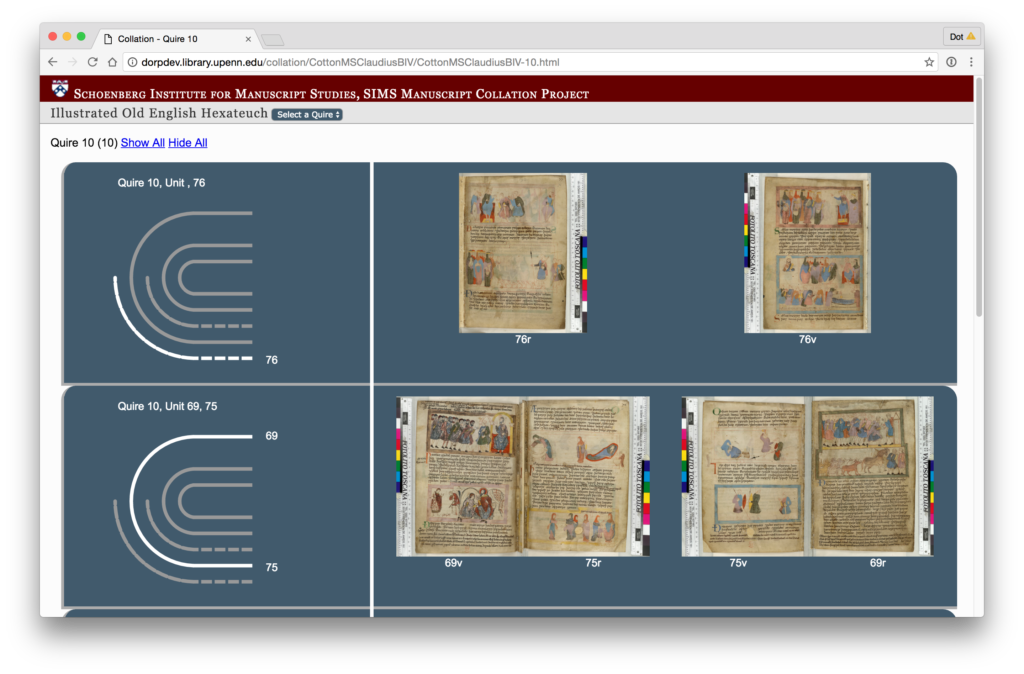
I’ve also been working for the past few years on developing a system for modeling and visualizing the physical collation of medieval manuscripts (this is distinct from textual collation which involves comparing versions of texts). With a bit of funding from the Mellon Foundation and the collaboration of Alexandra Gillespie and her team at the University of Toronto I am very excited for the next version of that system, which we call VisColl (it is on GitHub if like to check it out – you can see the code and there are instructions for creating your own models and visualizations). The next version will include facilities for connecting tags, and perhaps transcriptions, to the deconstructed manuscript. I hadn’t thought of the thing that this system generates as an edition, but perhaps it is. But instead of being an edition of a text, you might think of it as an edition of a manuscript that happens to have text on it (or sometimes, perhaps, won’t).
I am aware that I’m reaching the end of my time, so I just want to take a few minutes to mention something that I see playing an enormous role in the future of digital-manuscripts-as-editions, and that’s the International Image Interoperability Framework, or IIIF. I think Jeffrey Witt may mention IIIF in his presentation tomorrow, and perhaps others will as well although I don’t see any IIIF-specific papers in the schedule. At the risk of simplifying it, IIIF is a set of Application Programming Interfaces (APIs) – sets of routines, protocols, and tools – to enable the interoperability of image repositories. This means you can use images from different repositories in the same browser or other tool. Here, quickly, is an example of how that can work.
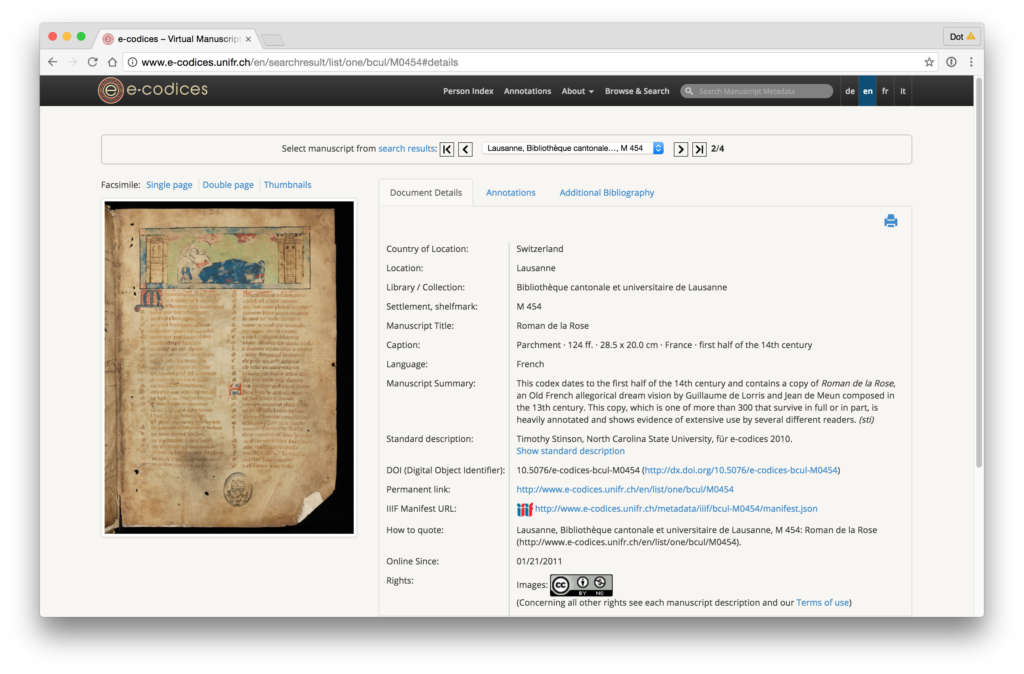
e-codices publishes links to IIIF manifests for each of their manuscripts. A manifest is a json file that contains descriptive and structural metadata for a manuscript, including links to images that are served through a IIIF server. You can look at it. It is human readable, kind of, but it’s a mess.
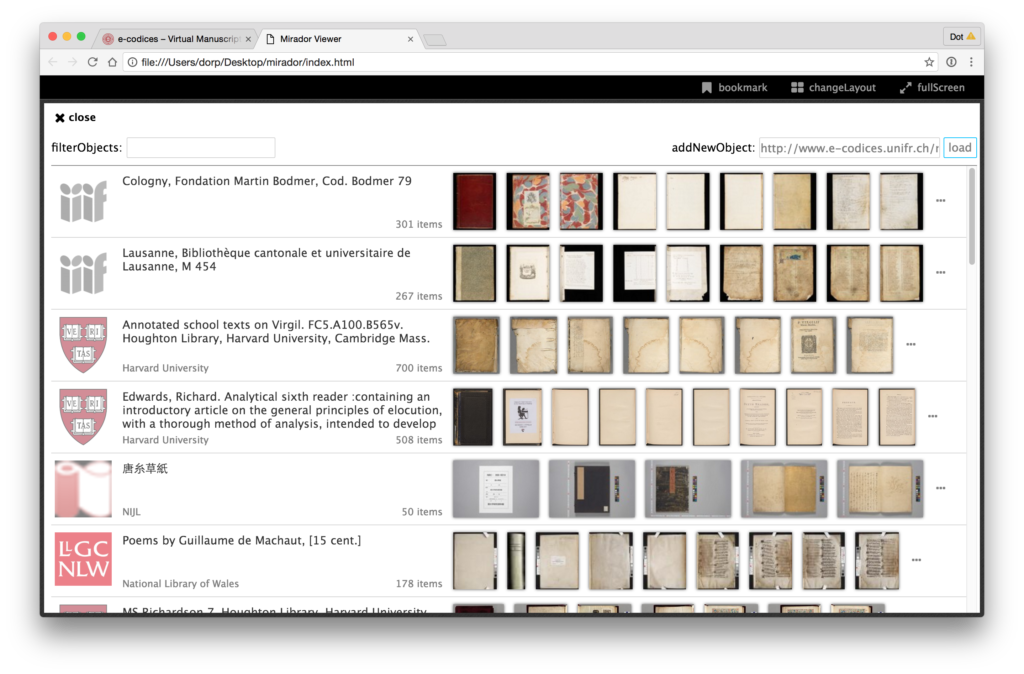
However, if you copy that link and paste it into a IIIF-conformant tool such as Mirador (a simple IIIF browser which I have installed on my laptop) you can create your own collection and then view and manipulate the images side-by-side. Here I’ve pulled in two manuscripts from e-codices, both copies of the Roman de la Rose.
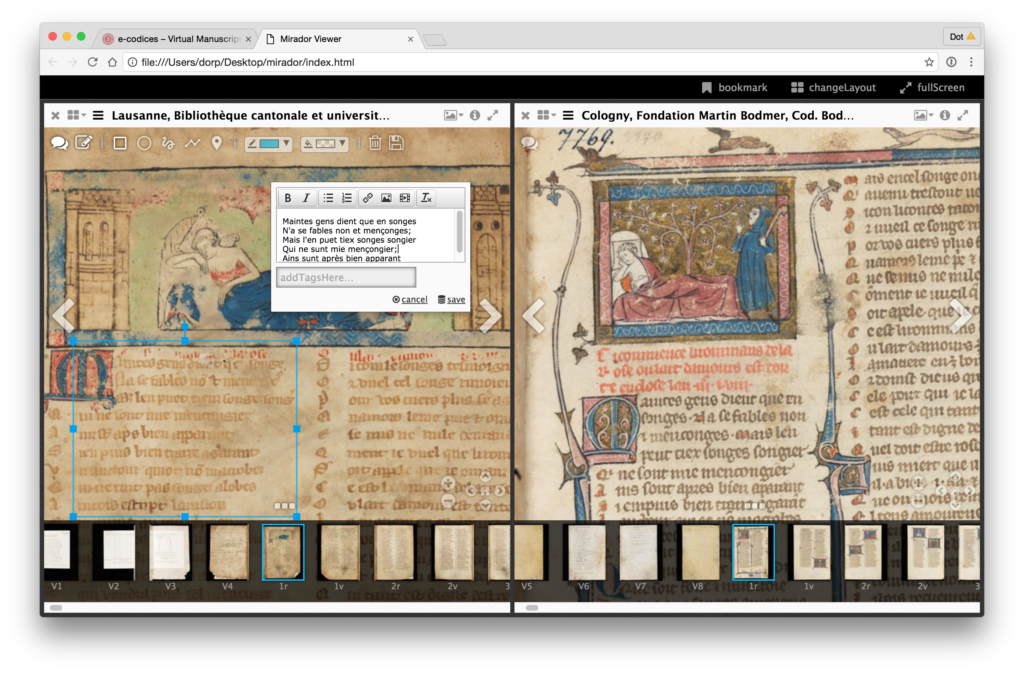
And here I can view them side by side, I can compare the images, compare the text, and I can make annotations on them too. Here is tool for creating editions of manuscripts.
(A quick side note: of course there are other tools that offer image tagging ability, including the DM project at SIMS, but what IIIF offers is not a single tool but a system for building and viewing editions, and all sorts of other unnamable things, using manuscripts in different institutions without having the move the images around. I cannot stress how radical this is for medieval manuscript studies.)
However as fond as I am of IIIF, and as promising I think it is for my future vision, my support for it comes with some caveats. If you don’t know, I am a huge proponent of open data, particularly open manuscript data. The Director of the Schoenberg Institute is Will Noel, an open data pioneer in his own right who has been named a White House Champion of Change, and I take him as my example. I believe that in most cases, when institutions digitize their manuscript collections they are obligated to release those images into the public domain, or at the very least under a creative commons: by license (to be clear, a license that would allow commercial use) and that manuscript metadata should be licensed for reuse. My issue with IIIF is that is presents the illusion of openness without actual openness. That is, if images are published under a closed license, if you have the IIIF manifest you can use them to do whatever you want, as long as you’re doing it through IIIF-compliant software. You can’t download them and use them outside of the system (to, say, generate PDF or epub facsimiles, or collation visualizations). I love IIIF for what it makes possible but I also think it’s vital to keep data open so people can use it outside of any given system.
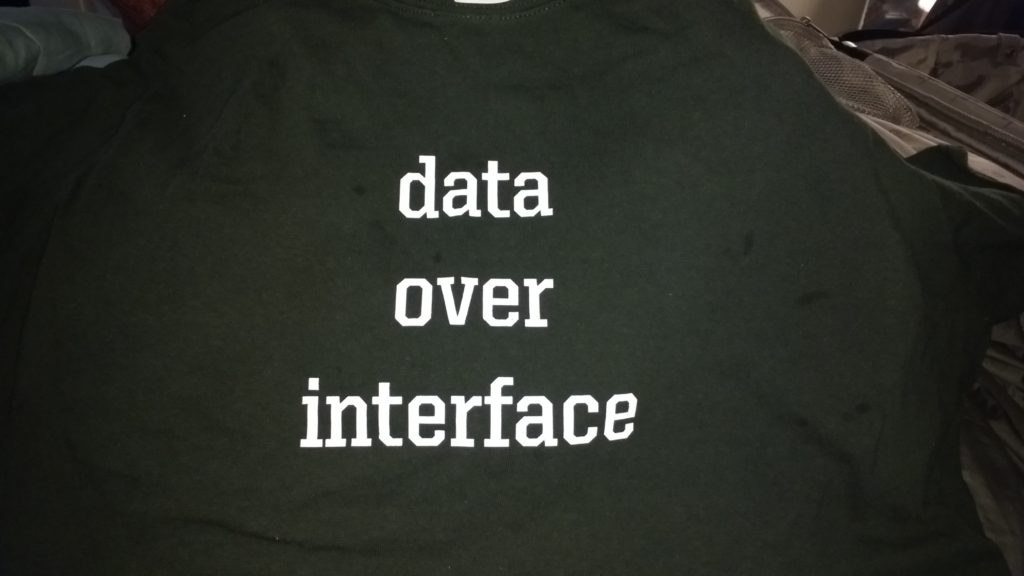
We have a saying around the Schoenberg Institute, Data Over Interface. It was introduced to us by Doug Emery, our data programmer who was also responsible for the curation of the data of the Archimedes Palimpsest Project and the Walters Art Museum manuscripts. We like it so much we had it put on teeshirts (You can order your own here!). I like it, not because I necessarily agree that the data is always more important than the interface, but because it makes me think about whether or not the data is always more important than the interface. Excellent, robust data with no interface isn’t easily usable (although a creative person will always find a way), but an excellent interface with terrible data or no data at all is useless as anything other than a show piece. And then inevitably my mind turns to manuscripts, and I begin to wonder, in the case of a manuscript, what is the data and what is the interface? Is a manuscript simply an interface for the text and whatever else it bears, or is the physical object data of its own that begs for an interface to present it, to pull it apart and put it back together in some way to help us make sense of it or the time it was created? Is it both? Is it neither?
I am so excited to be here and to hear about what everyone in this room is thinking about editions, and interfaces, and what editions are, and what interfaces are and are for. Thank you so much for your time, and enjoy the conference.
Presented September 23, 2016.
